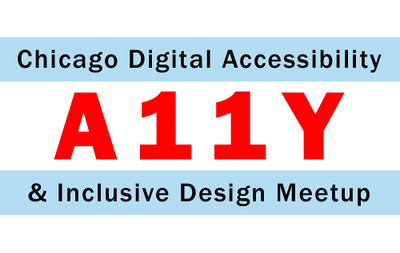 Dr. Jon Gunderson is the Coordinator of Assistive Communication and Information Technology Accessibility in the Division of Disability Resources and Education Services (DRES) at the University of Illinois in Champaign/Urbana, Illinois. He leads the development of open source web accessibility evaluation tools and coding practices resources to help web designers and developers understand accessible coding techniques.
Dr. Jon Gunderson is the Coordinator of Assistive Communication and Information Technology Accessibility in the Division of Disability Resources and Education Services (DRES) at the University of Illinois in Champaign/Urbana, Illinois. He leads the development of open source web accessibility evaluation tools and coding practices resources to help web designers and developers understand accessible coding techniques.
He is the past chair of the W3C User Agent Working Group and currently involved in the W3C ARIA Working Group. As a member of the W3C ARIA Working Group has been a major contributor to the ARIA Authoring Practices and the automated testing of ATIA implementation in browsers for the Windows platform. He has given numerous presentations, workshops and courses related to web accessibility. He leads the development of the Accessibility Inspector for Firefox and the Functional Web Accessibility Evaluator (FAE) service. The tools can be used to help verify the use of the HTML4, HTML5 and ARIA techniques to implement the requirements of the Section 508 and W3C Web Content Accessibility Guidelines 2.0.
Jon will present Understanding ARIA 1.1 and the ARIA Authoring Practices Guide at Accessibility Camp Chicago.
We asked Jon a few questions about his experience with digital accessibility, leading up to Accessibility Camp Chicago.
How did you initially get involved with digital accessibility?
I am the Coordinator of Accessible IT Group in the Division of Disability Resources and Education Services (DRES) at the University of Illinois in Champaign/Urbana, Illinois. I received my Ph.D. from the University of Wisconsin-Madison in Industrial Engineering with an emphasis in Human Factors. I hold B.S. and M.S. degrees from UW-Madison in Electrical and Computer engineering. As an undergraduate and graduate student in the 1980s, I worked with Dr. Gregg Vanderheiden at the Trace Research and Development Center on early augmentative communication systems and computer access technologies, including the Trine Augmentative Communication System based on the ESPON HX-20 portable computer, keyboard emulators for the Apple IIe, IBM PC and DEC VT 220 computer terminal, and the Long Rang Optical Pointer (LROP) a way to use head movement to type into a computer.
I started my current position at Illinois in 1995 and am responsible for helping the campus understand the accessibility issues of its online administrative and instructional resources and works with campus IT professionals and instructors to improve accessibility. I am the past chair of the W3C User Agent Working Group and currently a participant in the W3C WAI ARIA working group and am particularly interested in the development of authoring practices and implementation testing of ARIA and HTML5 technologies. I lead the development group working on open source web accessibility evaluation tools including AInspector Sidebar add-on for Firefox browser, Functional Accessibility Evaluator (FAE) 2.0, Accessibility Bookmarklets and the A11yFirst project for CKEditor. I am the primary software developer of the open source OpenAjax Accessibility Evaluation library used in AInspector Sideber and Functional Accessibility Evaluator (FAE) 2.0 to evaluate web content for W3C Web Content Accessibility Guidelines (WCAG) 2.0 Level A and AA requirements.
I’ve taught numerous online courses and workshops on accessible web design including courses on using the new W3C Accessible Rich Internet Application (ARIA) specifications to create accessible web applications. I also present at national conferences on web accessibility. I participate and lead both regional and national consortiums of higher educational institutions to promote and work together on improving information technology access in higher education.
Do you feel that interest in accessibility is picking up momentum? How have you seen this?
There is a growing demand for accessible electronic products and services, that is driven by consumer demand for equal access. For many years people with disabilities that could not or had poor access to information technologies could find other ways around the use of technology. But is no longer true for most people with disabilities, and if they want to participate as equals in society they need to have the same access as everyone else to online resources. I have almost 40 years of experience in technology and disability, I have seen in the past few years information technology going from a “nice thing to do” to being a “must have” for many organizations and companies.
What are the major challenges that you are seeing in making sites and applications accessible?
The biggest issue is a human resource issue, people making technology decisions, design and development teams and quality assurance people do not understand what accessibility looks like, or their role in assuring products and services are accessible. A big part of this problem is not only how are people going to learn about accessibility and their role in the product development and support process, but also how to people develop a feeling of confidence that the accessibility features of a product is what is actually needed to benefit people with disabilities.
What are the examples of success that you have seen in the wild?
I think the establishment of the International Association of Accessibility Professionals (IAAP) is a clear example that there is a growing group of people doing this work to warrant a professional society. IAAP provides a place for people (especially new people) to come together to learn about what other accessibility professionals are doing, get support from their peers, building a knowledge base for certifying practitioners for work in this field and validate that their skills, knowledge and experience is making a difference for people with disabilities.
What is the one thing that excites you the most about your work in accessibility?
The enthusiasm of many of the new people who have become aware of the need for accessibility and who are working to make information technologies accessible and usable by people with disabilities. Most people when they become aware of the online accessibility issues are very sympathetic to the issue, and as this number of people grows it will help build momentum within organizations to transform how they design and build products to make universal design a primary design goal of the product development process.
If you haven’t already registered for Accessibility Camp Chicago, register today!
